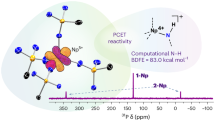Abstract
Non-stoichiometric compounds or solids in which the ratios of the amounts of elements present are not integral may be characterized by the formula MXx where x is non-integral and, in many crystalline compounds, may vary over quite a wide range without change of structure type. Ideally the thermodynamic stability and physical properties of such compounds should be related to the same atomic and electronic model but the ways in which various simple structures adapt to departures from ideal composition have not been adequately explored. Models based on a random distribution of point defects have proved successful but selected area electron diffraction and ultra high resolution electron microscopy have shown that their distribution is not simple. Interaction between defects produces microscopic sub-structures or clusters introducing specific local properties. Although our knowledge of the principal morphological features of sub-structures has advanced, their precise interatomic arrangements are generally unknown. Here we derive a model for non-stoichiometric oxides of uranium.
This is a preview of subscription content, access via your institution
Access options
Subscribe to this journal
Receive 51 print issues and online access
$199.00 per year
only $3.90 per issue
Buy this article
- Purchase on Springer Link
- Instant access to full article PDF
Prices may be subject to local taxes which are calculated during checkout
Similar content being viewed by others
References
Willis, B. T. M. Nature 197, 755–756 (1963).
Willis, B. T. M. Acta crystallogr. A34, 88–90 (1978).
Bevan, D. J. M., Greis, O. & Strähle, J. Acta crystallogr. A36, 889–890 (1980).
Martin, R. L. J. Proc. R. Soc. N.S.W. 109, 137–150 (1976).
Allen, G. C., Tucker, P. M. & Tyler, J. W. JCS chem. Commun. 691–692 (1981).
Willis, B. T. M. J. Phys. Radiat. 25, 431–439 (1964).
Thornber, M. R. & Bevan, D. J. M. J. Solid-St. Chem. 1, 536–544 (1970).
Allen, G. C., Griffiths, A. J. & Lee, B. J. Transition Metal Chem. 3, 229–233 (1978).
Verbist, J., Riga, J., Pireaux, J. J. & Caudano, R. J. Electron Spectros. relat. Phenom. 5, 193–205 (1974).
Allen, G. C., Tucker, P. M. & Tyler, J. W. J. phys. Chem. (in the press).
Allen, G. C., Griffiths, A. J. & Suckling, C. W. Chem. Phys. Lett. 53, 309–312 (1978).
Belbeoch, B., Boivineau, J. C. & Perio, P. J. Phys. Chem. Solids 28, 1267–1275 (1967).
Author information
Authors and Affiliations
Rights and permissions
About this article
Cite this article
Allen, G., Tempest, P. & Tyler, J. Coordination model for the defect structure of hyperstoichiometric UO2+x and U4O9. Nature 295, 48–49 (1982). https://doi.org/10.1038/295048a0
Received:
Accepted:
Issue Date:
DOI: https://doi.org/10.1038/295048a0
This article is cited by
-
Modulated structure determination and ion transport mechanism of oxide-ion conductor CeNbO4+δ
Nature Communications (2020)
-
Extreme multi-valence states in mixed actinide oxides
Communications Chemistry (2019)
-
Microstructural analysis of pitchblende in the Miaoershan area using TEM lattice imaging
Mineralogy and Petrology (2019)
-
Interstitial oxide ion conductivity in the layered tetrahedral network melilite structure
Nature Materials (2008)
-
Complex defects in the oxidation of uranium
Metallurgical Transactions A (1986)
Comments
By submitting a comment you agree to abide by our Terms and Community Guidelines. If you find something abusive or that does not comply with our terms or guidelines please flag it as inappropriate.



